Taurus Constellation: Facts, location and stars of the Bull
The bull is hard to miss as it charges through the northern winter sky.
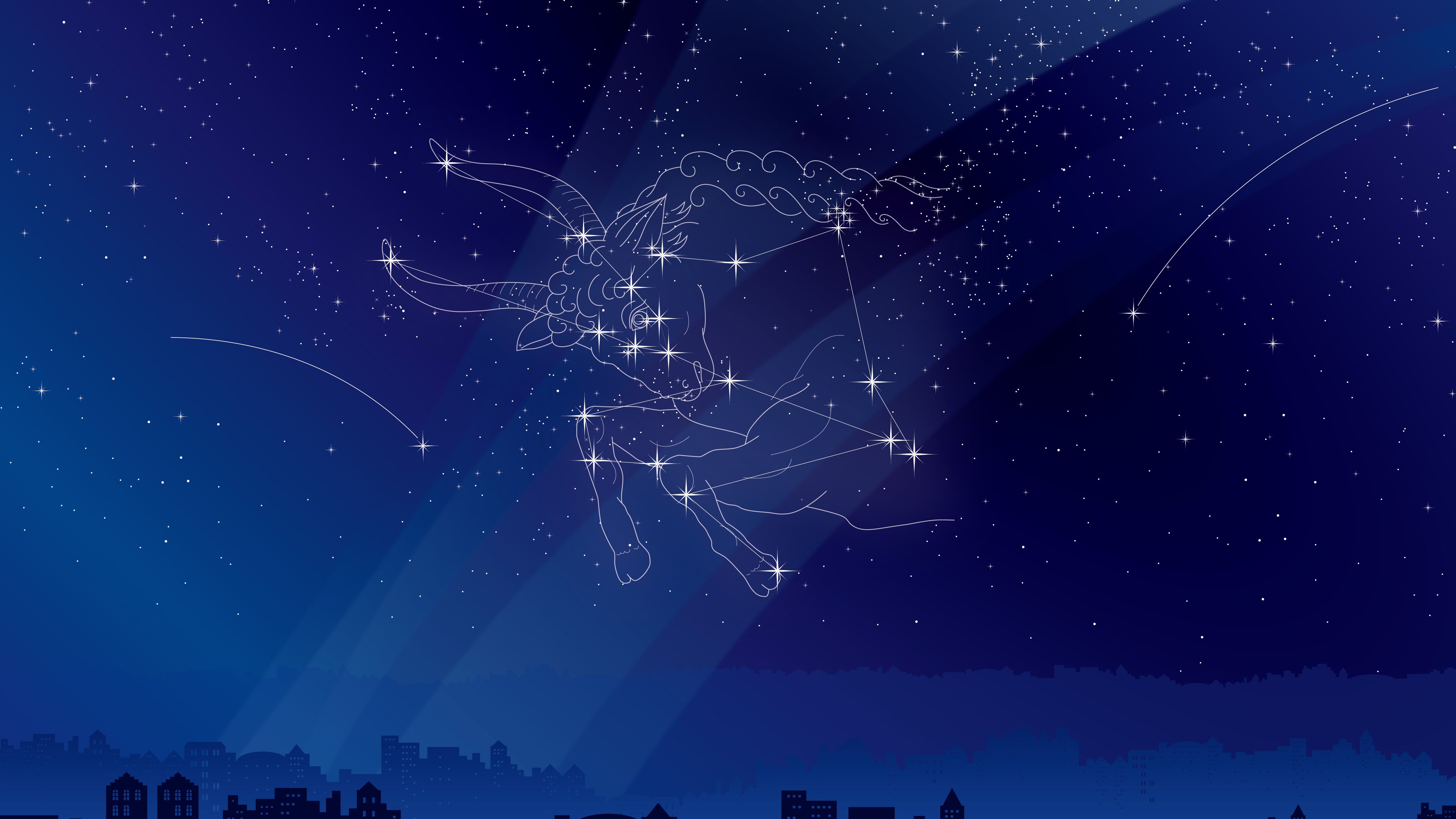
Taurus the bull is one of the most well-known and noticeable constellations in the sky over Earth.
Taurus is the sixth largest of the Zodiac constellations and the 17th largest constellation overall, occupying around 797.2 square degrees or 1.9% of the sky over Earth, according to Astronomy Trek.
Taurus is one of the twelve Zodiacal constellations recognized by the Babylonians in the 5th century B.C.E. Zodiacal constellations are defined by Star Walk as constellations that are located along the path of the sun in the sky, also known as the elliptic. The sun passes through Taurus each year between mid-May and mid-June, according to In the Sky.
Observations of Taurus date back as far as the stone age, and as such, the celestial bull weaves its way through the myths and legends of our ancestors. Today, the constellation is a popular observing target for astronomers of all skill levels, home to some of astronomy's most fascinating stars and cosmic objects. But, before you can dive into the constellation, you'll have to hunt for the bull.
Related: Night Sky, 2023: What you can see tonight
Where and when can you see Taurus?
According to In the Sky, Taurus is a prominent northern constellation that is highest in the sky over the northern hemisphere in the months around December and January. Taurus is visible in the northern hemisphere between Fall (Autumn) and Spring and in the southern hemisphere between spring and fall.
The bull-shaped Taurus is comprised of what appears to be a two-pronged fork of stars, with the central "v" and the head of the bull made of the Hyades star cluster. Though the constellation is fairly easy to spot to hunt the bull, EarthSky recommends first locating the constellation of Orion, the hunter, fittingly enough. First, find the three stars that comprise Orion's belt, then draw a line sweeping upwards to lock on to the brightest star of its neighbor Taurus Aldebaran — a bright red star often called the "eye of the bull" due to its position within the constellation.
Other neighboring constellations of Taurus are Aries, Auriga, Cetus, Eridanus, Gemini, and Perseus. The celestial coordinates of Taurus are right ascension 4 hours, declination 15 degrees, with the bull best visible between latitudes 90 degrees and minus 65 degrees.
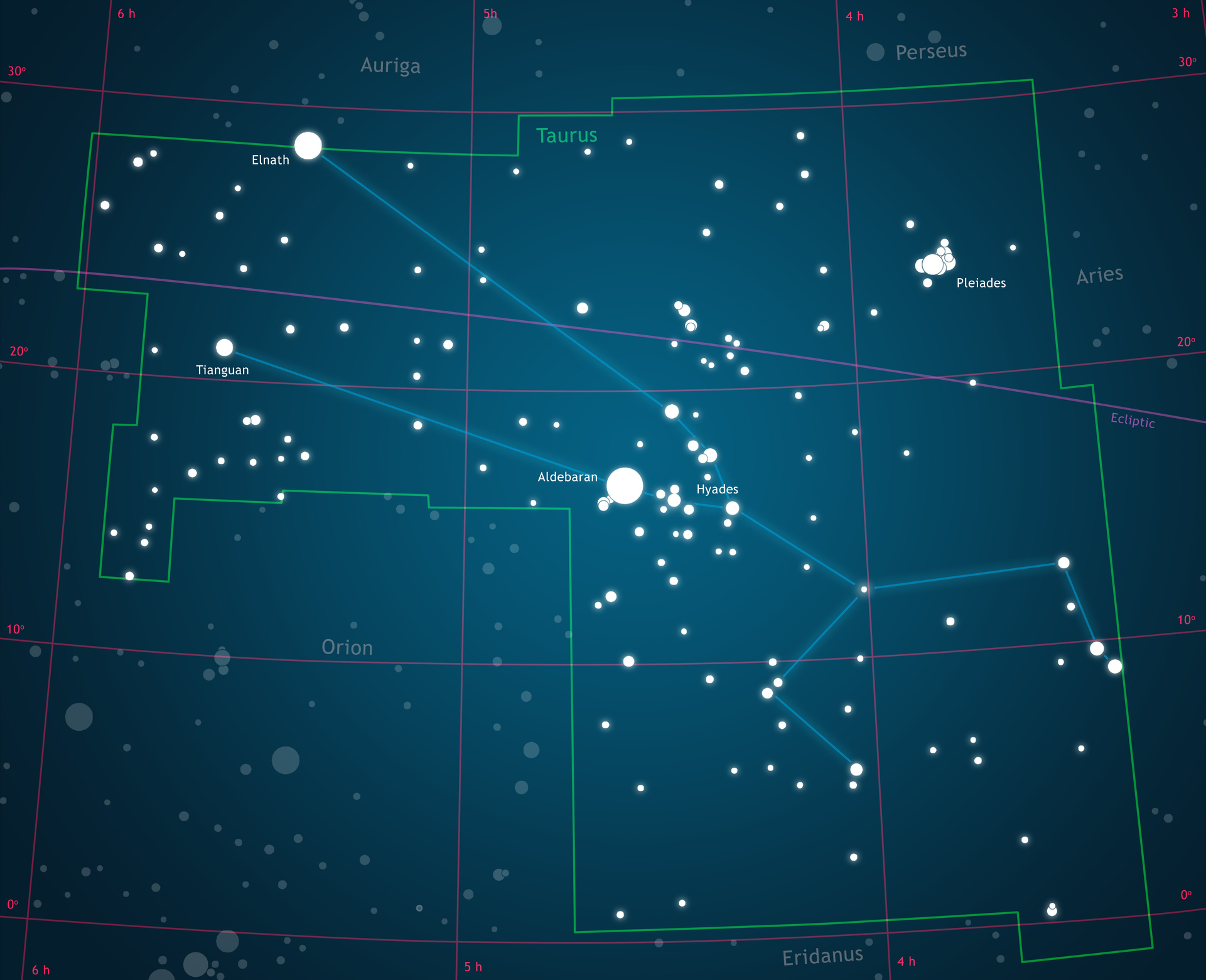
Observing targets in Taurus
As you may imagine, for a constellation that occupies so much of the sky over Earth, it's no bull to say the potential celestial targets for astronomers in Taurus are too numerous to list. Here are some of the most interesting cosmic objects within the bounds of the bull.
Jargon buster
Magnitude: An object's magnitude tells you how bright an object is as it appears from the Earth. In astronomy, magnitudes are represented on a numbered scale. Quite confusingly the lower the number, the bright the object. For example, an object of a -1 magnitude is brighter than one with a magnitude of +2.
Right ascension (RA): Right ascension is to the sky what longitude is to the surface of the Earth, corresponding to east and west directions. Measured in hours, minutes and seconds since, as Earth rotates, we see different parts of the sky through the night
Declination (Dec): Tells you how high your object will rise in the sky. Like Earth's latitude, declination measures north and south. Its units are degrees, arcminutes and arcseconds. There are 60 arcmins in a degree and 60 arcsecs in an arcmin.
The Bull's Eye Aldebaran
Magnitude: +0.85
Approximate distance from Earth: 65 light-years
Location: 4h 35m 55s (right ascension), +16° 30' 33" (declination)
The eye of the celestial bull is Aldebaran, also known as Alpha Tauri due to its status as the brightest star in Taurus, is one of the 15 brightest stars over Earth with a magnitude of 0.85, according to Britannica.
Aldebaran, which means "the follower" in Arabic a name that refers to the fact it follows the Pleiades star cluster across the sky, is located around 65 light years from Earth. It is an example of a red giant star, the phase that stars like the sun enter when they exhaust hydrogen for nuclear fusion, causing their cores to collapse and their outer layers to puff out. As such, the red giant star is around 44 times as wide as the sun despite having just 1.2 times the mass of our star.
The star was once believed to be part of the cluster the Hydaes, which astronomers now know is more distant than Aldebaran.
The Pleiades
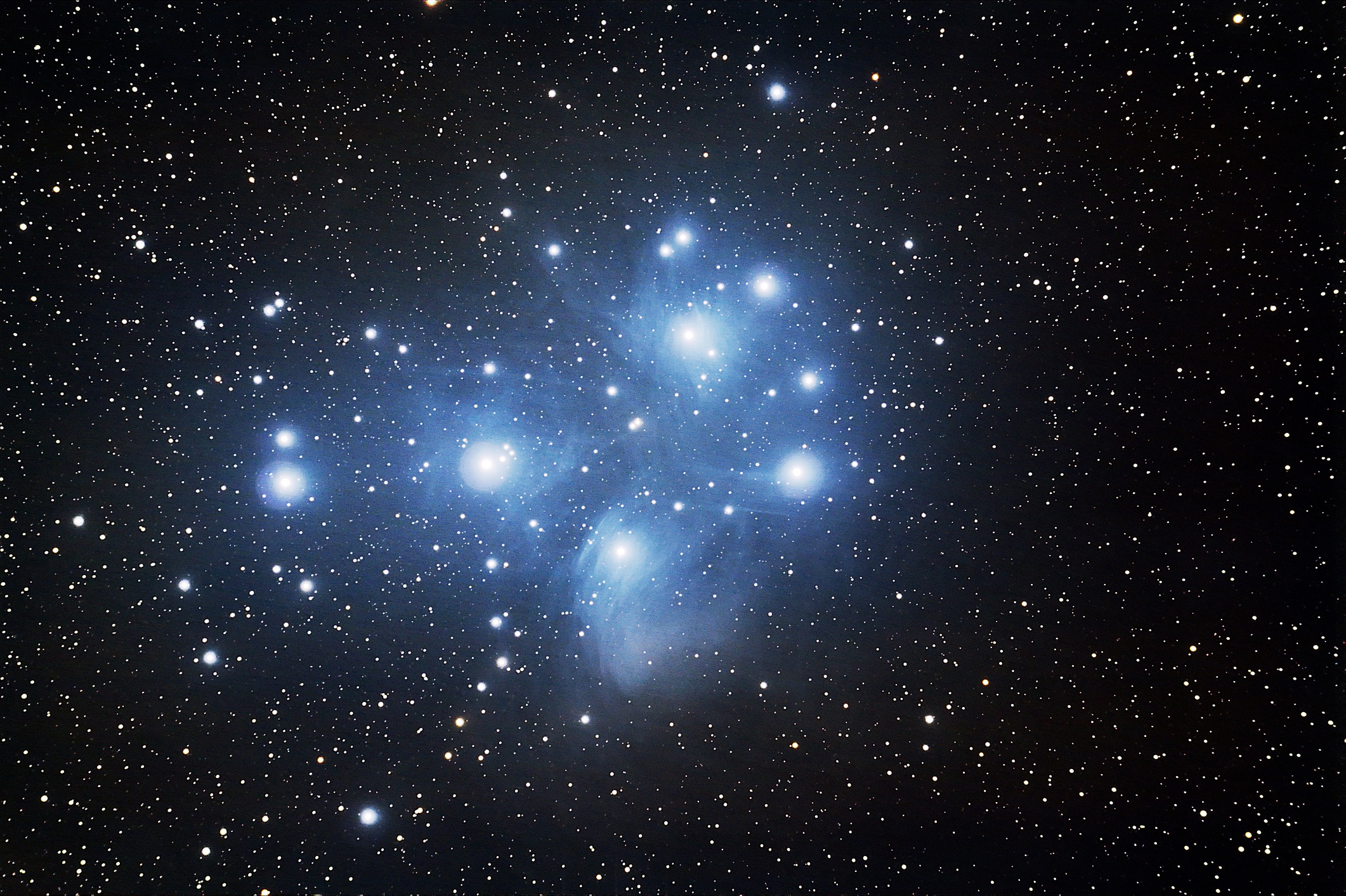
Magnitude: 1.6
Approximate distance from Earth: 440 light-years
Location: 3h 47m 24s (right ascension), +24°07' 0" (declination)
The Pleiades is a bright open star cluster within Taurus, also known as Messier 45 (M45), NGC 1432, and in reference to Greek legend, "the Seven Sisters". Open star clusters are defined as groups of stars that all form from the same cloud of gas and dust and Taurus is replete with them.
The Pleiades is located around 440 light years from Earth and is made up of around 1,000 stars, seven or eight of which can be seen with the naked eye from Earth. The stars of the Pleiades are young and hot, estimated to be just around 100 million years old, virtual infants in comparison to 4.5 billion-year-old stars like the sun and the 13.8 billion-year-old universe.
This relative youth and the massive size causes these stars to glow blue, and this blue color is reflected by an independent cloud of gas and dust called a reflection nebula which is drifting through the cluster at a relative speed of about 6.8 miles per second (11 kilometers per second). NASA says it is this reflection nebula that gives the cluster its "nebulosity," with the gas and dust from which the stars of this open cluster formed having been dispersed long ago.
The brightest stars of the Pleiades are named after Altas and Pleione and their daughters in Greek myth— Alcyone, Electra, Maia, Merope, Taygeta, Celaeno, and Asterope (comprised of two stars, Sterope I, and Sterope II). Their magnitudes range from 2.86 (Alcyone or 25 Tauri) to 6.41 (Sterope II or 22 Tauri).
The Seven Sisters is not the only star cluster that even amateur astronomers can spot in the constellation of Taurus.
The head of the bull: The Hyades
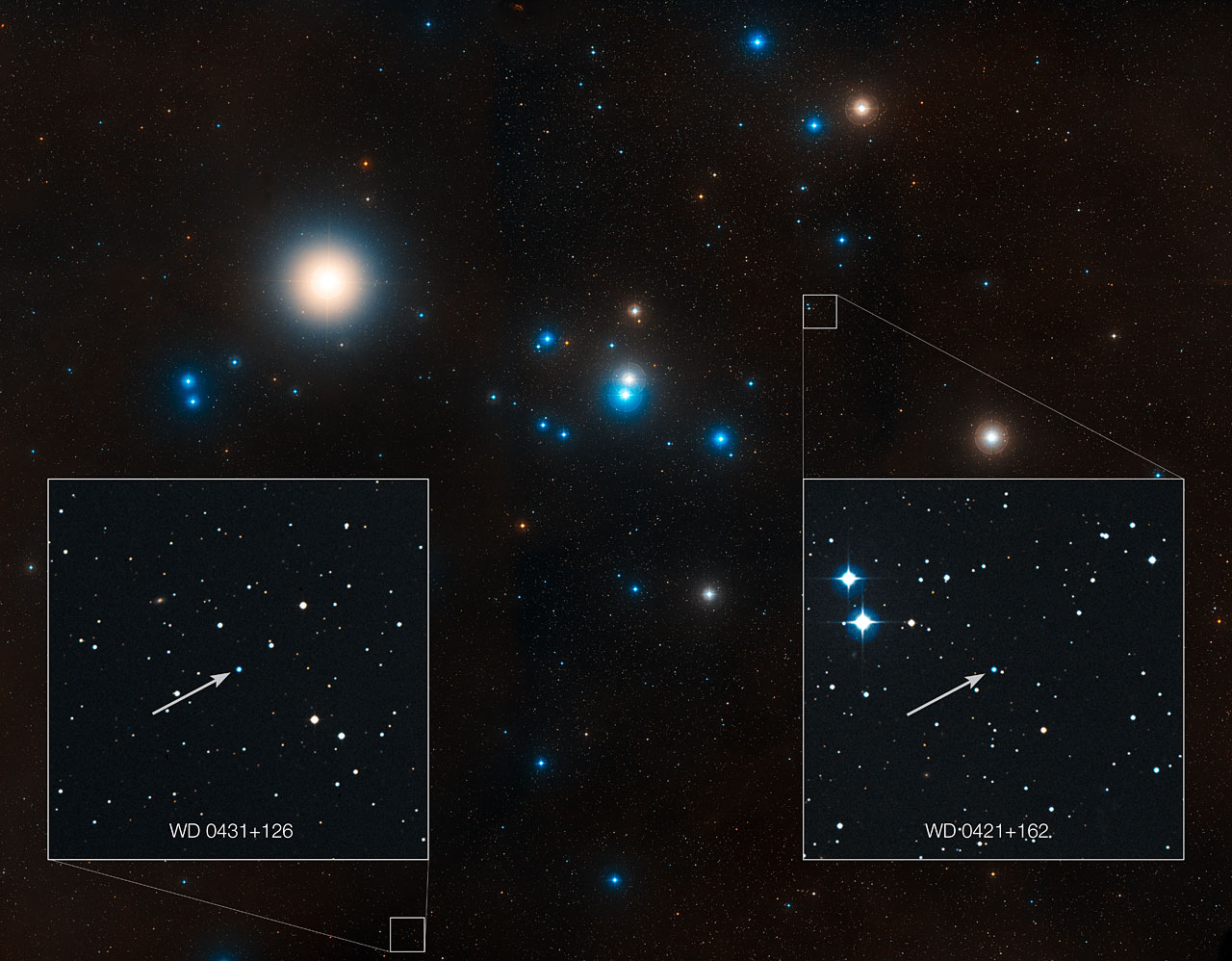
Magnitude: 0.5
Approximate distance from Earth: 150 light-years
Location: 04h 27m (right ascension), +15°52' (declination)
Forming the v-shapes "head" of Taurus is the Hyades cluster, another open star cluster that EarthSky says is one of the closest star collections of this kind to Earth at a distance of just 150 light-years away. The Hydaes cluster takes its name from the half-sister of Pleiades in Greek mythology, but there is little relationship between the two clusters in cosmic terms, however.
In contrast to the young blue stars of the Pleiades, the stars of the Hyades are older red giants and white dwarfs, stellar remnants that form when the outer layers of stellar material from red giants move away, leaving a smoldering but cooling stellar core. This indicates that the Hyades is older at around 600 million years old.
The Bulls' Horn the Crab Nebula
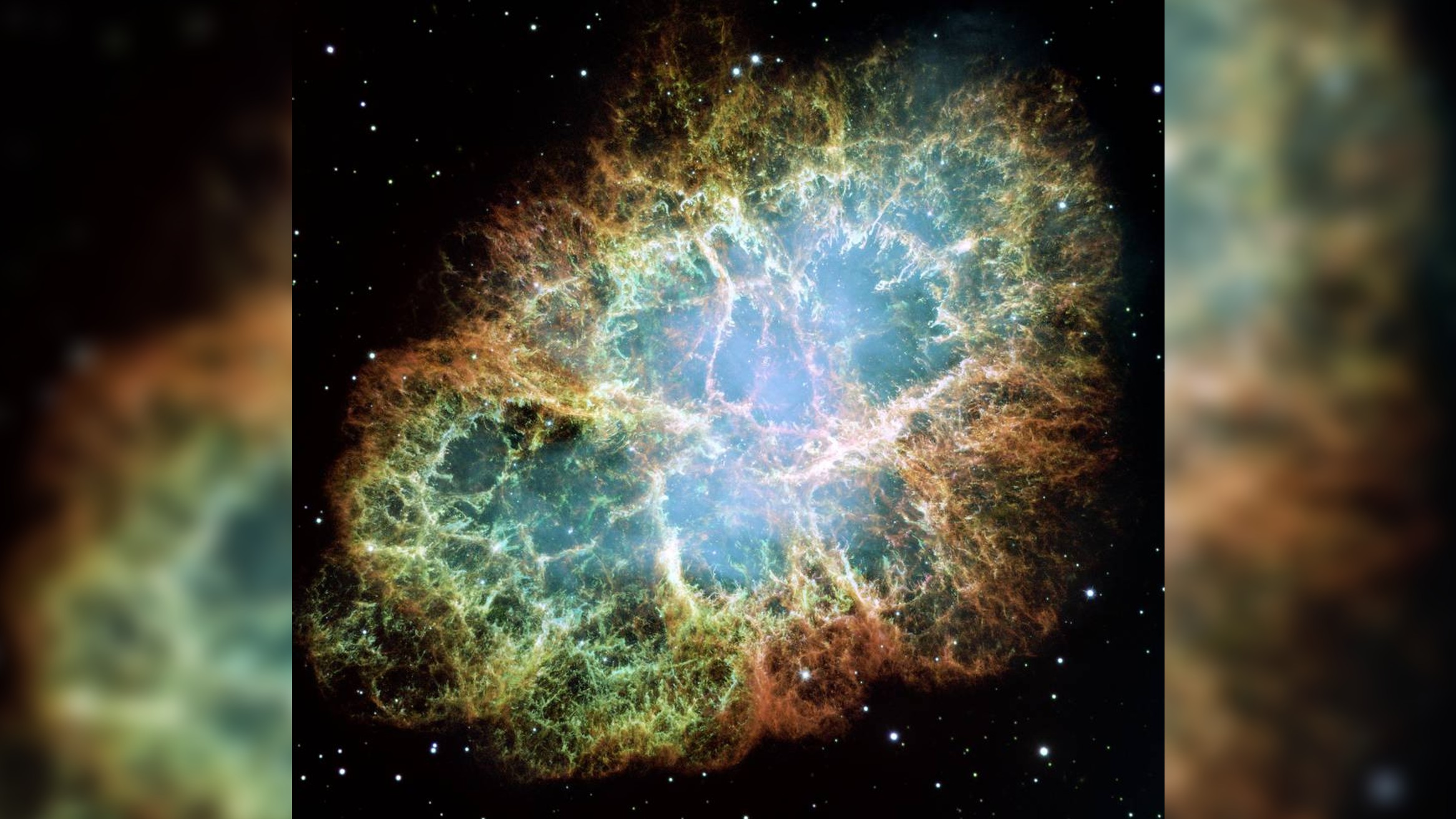
Magnitude: 8.4
Approximate distance from Earth: 6,500 light-years
Location: 5h 34m 32s (right ascension), +22° 00' 52" (declination)
Another object with a Messier designation in Taurus is the Crab Nebula, which is also known as Messier 1 (M1), NGC 1952, and Taurus A.
The Crab Nebula is a six-light-year-wide remnant of a supernova blast that was spotted over the skies of China in July 1054. The blast was visible for just 23 days, according to Britannica, and it was bright enough to see during daylight, with its temporary nature earning it the name "guest star."
The supernova remnant is located around 6,500 light years from Earth and has a magnitude of around 8.4. This makes the Crab Nebula bright enough to spot with even a small telescope, with January being an ideal month to attempt this. Finding the nebula is easy enough as it is located just below the lower horn of the constellation Taurus.
Good viewing conditions could reveal some of the structure of the crab nebula, but what can't be easily viewed is the rapidly spinning neutron star or pulsar lurking at the heart of the nebula. This dense stellar remnant was born from the death of a massive star which also triggered the supernova that created the Crab Nebula wreckage. This spinning neutron star is the source of twin beams of radiation that make the neutron star appear to pulse 30 times every second and gives the Crab Nebula an eerie blue glow at its heart.
While studying the horns of Taurus, star watchers may also want to spy on stars at the tip of this celestial headgear. One of these stars is Beta Tauri (Elnath), the second brightest star in Taurus and a blue-white giant star with a magnitude of 1.65 located 134 light years from Earth.
The other star at the tip of the celestial bull's horns is the blue-white star Zeta Tauri (Tianguan) which is actually a binary system located around 417 light years from Earth.
Taurus has galaxies too!
In addition to its stars and open clusters, the constellation of Taurus is populated with a wealth of galaxies. The brightest galaxy in Taurus, with a magnitude of 11.7, is the elliptical galaxy NGC 1587, according to In the Sky, which is located around 165 million light-years from Earth.
Also notable in Taurus are the colliding galaxies NGC 1409 and NGC 1410, which together are also known as UGC 2821 and are located around 300 million light-years from Earth. Mutual centers of these galaxies are tightly bound together by gravity and are just 23,000 light years apart.
As the galaxies which clashed around 100 million years ago whip around each other at a speed of around 670,000 miles per hour, around 450 times as fast as a jet fighter's top speed, a "pipeline" stretches the 20,000 plus light-years between the galaxies funneling material from NGC 1410 to NGC 1409.
The Taurid meteor shower
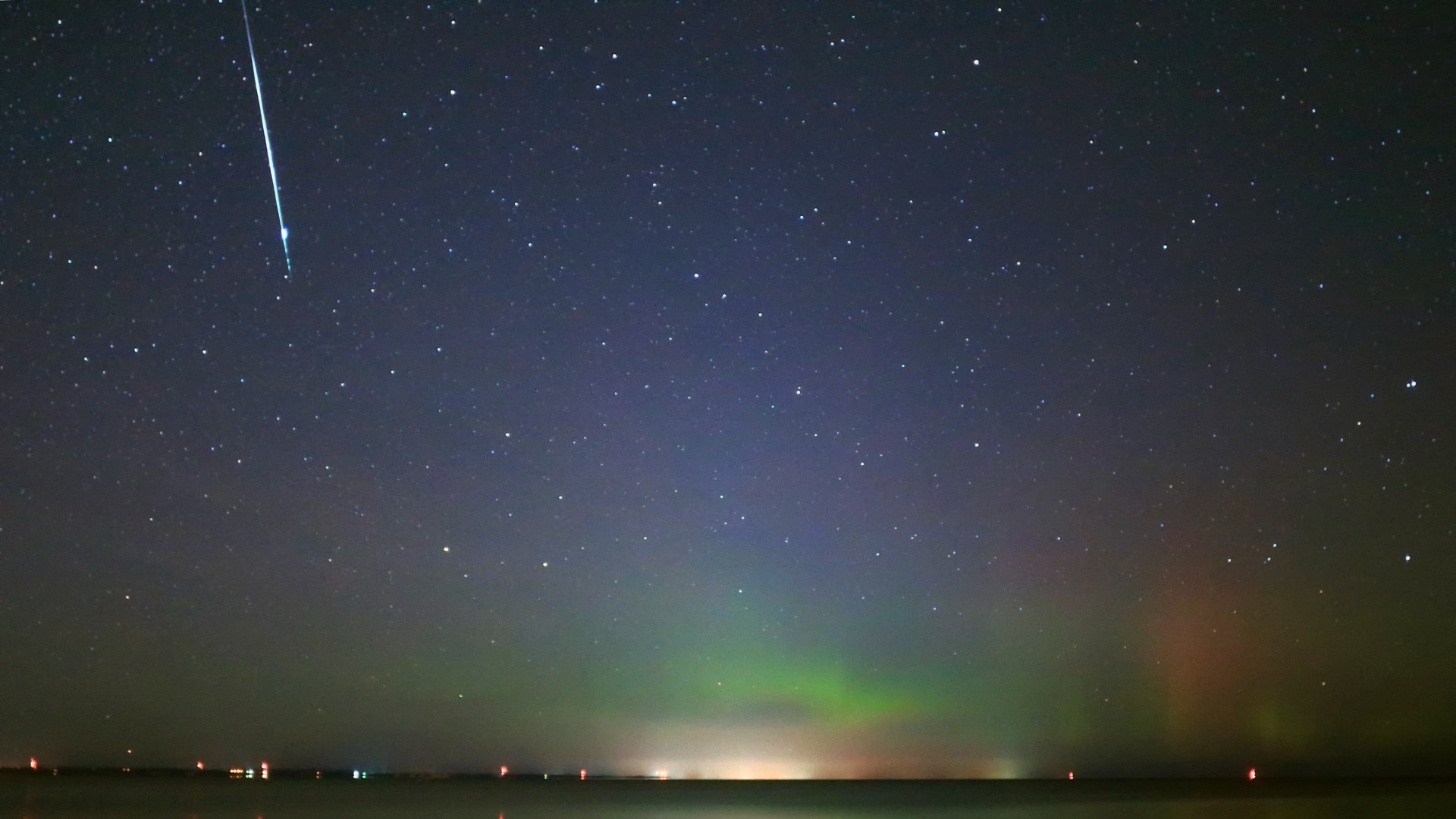
Between October and December each year, Earth passes through a cloud of debris left in the vicinity of the sun by Comet 2P/Encke (Encke).
As the nearly 3-mile-wide (4.8-kilometer) comet approaches the sun, radiation from the star heats material turning solid matter in Encke's shell straight into gas, a process called sublimation. This blows away fragments that not only make up the characteristic glowing tail and aura, or coma, of the comet but also leave behind the fragments for Earth to pass through annually.
The fragments of Encke enter the atmosphere at speeds of around 68,000 miles per hour (109,000 kilometers per hour), burning up and generating streaks of light or meteors with occasional larger pebble-sized debris fragments creating bright fireballs.
So why is this relevant to Taurus? As the name suggests, when the meteors of the Taurid shower stream into Earth's atmosphere, they appear to do so from the bullish constellation of the same name.
Taurus FAQs answered by an expert
We asked Italian amateur astronomer, astrophotographer, and author Giuseppe Donatiello some questions about the Taurus constellation.

Giuseppe Donatiello is an Italian amateur astronomer, astrophotographer, and author who is known for his discovery of six nearby dwarf galaxies and several planetary nebulas.
Where is the Taurus constellation?
Taurus is a typical winter constellation located between the constellations Orion, Auriga, Eridanus, and Aries. Being crossed by the ecliptic–the projection of the Earth's orbit in the sky– it is one of the zodiacal constellations.
How can astronomers find and photograph Taurus?
Despite being north of the Celestial Equator, it is still observable from every terrestrial latitude at certain times of the year. In the early evening, it rises in the east in late summer and sets in the west in late spring.
The constellation Taurus can be photographed with a common wide-angle lens with which neighboring constellations can be included. However, at longer focal lengths, her jewels can be better captured. No large telephoto lenses are needed, so focal lengths of 135 and 200 mm are optimal for both the Pleiades and the Hyades. With these focal lengths, we can get an overview and the surrounding environment. With longer focal lengths, we get a partial view of these two large clusters. M1 and the Hind Variable Nebula are best photographed with telescopes for greater detail.
What are some of the interesting observing targets in the constellation?
In Taurus, there are some of the most beautiful objects in the whole sky. Undoubtedly, the most beautiful is the open cluster of the Pleiades, also known as Messier 45.
The Pleiades are probably the most famous open star cluster. It consists of about a thousand stars, mostly faint. Just about twenty are above the threshold of visibility with the naked eye. The brightest are all stars of class B, A, and F with masses less than 8 times that of the Sun. This means that class O stars, born with the cluster, have already exploded as supernovae.
Although less than 100 million years old, M45 is no longer a young cluster but in the process of progressive disintegration. To give the impression that M45 is a young cluster is the presence of a faint reflection nebula, erroneously believed to be a legacy of its formation. In reality, the cluster has already swept away its gaseous birth cloud many millions of years ago and is now simply passing through a thick cirrus cloud of dust. The stars in the cluster merely illuminate this cirrus system, part of the larger Molecular Cloud in Taurus. This expansive cloud is a favorite target for astrophotographers as it is surrounded by intriguing structures and dark nebulae.
The brightest star is Aldebaran (magnitude 0.85), set in the Hyades asterism, which represents the head of Taurus. It is a variable and multiple giant star and the 13th brightest star in the sky. Aldebaran is moving away from us at a speed of +54.11 km/s. Astronomers have calculated that for about 200 thousand years, it was the brightest star in the sky. It reached its peak brightness 320,000 years ago when the star was about 21.5 light-years from Earth. At that time, it appeared as bright as the star Sirius is now.
How many stars are in the Taurus constellation?
The constellation contains 17 stars up to the fourth visual magnitude, almost all with a proper name. They are essentially those that draw the figure of the constellation. However, from a very dark location, about 160 of them can be seen with the unaided eye above magnitude 6, according to the Harvard Revised Bright Star Catalogue. Among them are a number of interesting variable stars.
The constellation contains at least 85 deep-sky objects, but they are mostly very faint galaxies. In Taurus, however, there are some of the most beautiful objects in the whole sky.
At the heart of the constellation Taurus is a V-shaped asterism which is, in truth, another open cluster, only second in distance to the moving group of the Big Dipper at just 80 light-years. We are talking about the Hyades cluster. Its distance is only 150 light years away, and it has an estimated age of about 600 million years.
Aldebaran occupies the southern tip of the V but is not part of the cluster, being 66.64 light-years away. These stars also faintly scatter the light of cirrus clouds of interstellar dust. This light is visible in long-exposure astrophotography.
Other fainter clusters within its boundaries are New General Catalog (NGC) 1746, NGC 1647, and NGC 1807. NGC 1746 can be identified with binoculars, 5 degrees southwest of the star β Tauri (the vertex of the Auriga pentagon), in an area poor in stars due to the presence of extensive dark nebulae.
Additional resources
If you want to learn more about the wealth of myth and legends surrounding Taurus Under Richard J Bartlett explains here. Taurus is replete with a wealth of open star clusters, the European Space Agency (ESA) explains why these collections of stars are so fascinating. The eye of Taurus is a huge red giant star, a star phase that our sun will enter in around 5 billion years. Read about that process and why it is bad news for our planet with these ESA resources.
Bibliography
D. Ford., The Constellation Taurus, In the Sky [Acessed 06/10/23], [https://in-the-sky.org/data/constellation.php?id=80]
Zodiac constellations and zodiac signs, Sky Walk, [Acessed 06/10/23], [https://starwalk.space/en/news/zodiac-constellations#what-are-the-zodiac-constellations]
J. Miller, Star Constellations | The Zodiac, Astronomy Trek, [Accessed 20/06/23], [https://www.astronomytrek.com/star-constellations-the-zodiac/]
B. McClure., Meet Taurus the Bull in the evening sky, EarthSky [Acessed 06/10/23], [https://earthsky.org/constellations/taurus-heres-your-constellation/).]
Aldebaran, Britannica, [Accessed 06/10/23], [https://www.britannica.com/place/Aldebaran]
Aldebaran Star | The Eye of the Bull, Astro Backyard, [Acessed 16/10/23], [https://astrobackyard.com/aldebaran-star/]
Ghostly Reflections in the Pleiades, NASA Hubblesite, [Acessed 16/10/23], [https://hubblesite.org/contents/media/images/2000/36/1009-Image.html]
Pleiades, Britannica, [Acessed 16/10/23], [https://www.britannica.com/place/Pleiades-astronomy]
Tianguan - ζ Tauri (zeta Tauri), The Sky Live, [Acessed 16/10/23], [https://theskylive.com/sky/stars/tianguan-zeta-tauri-star]
Intergalactic 'Pipeline' Funnels Matter Between Colliding Galaxies NGC 1410 and NGC 1409, NASA Hubblesite, [Accessed 16/06/23], [https://hubblesite.org/contents/media/images/2001/02/1013-Image.html?news=true]
Join our Space Forums to keep talking space on the latest missions, night sky and more! And if you have a news tip, correction or comment, let us know at: community@space.com.
Get the Space.com Newsletter
Breaking space news, the latest updates on rocket launches, skywatching events and more!

Robert Lea is a science journalist in the U.K. whose articles have been published in Physics World, New Scientist, Astronomy Magazine, All About Space, Newsweek and ZME Science. He also writes about science communication for Elsevier and the European Journal of Physics. Rob holds a bachelor of science degree in physics and astronomy from the U.K.’s Open University. Follow him on Twitter @sciencef1rst.










